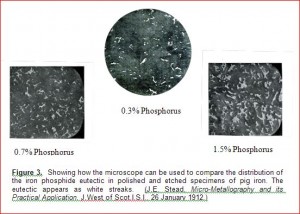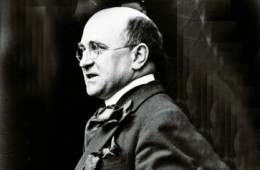John Edward Stead
John Edward Stead, FRS (1851-1923) – Chemist and Metallurgist
by David Rowe
Early Life and Education
By heredity John Stead had a Yorkshire and metallurgical background. His grandfather, Wharfedale-born George Stead was a proprietor of a Sheffield wheel, a cutlery workshop using water-power. George and his sons, including Johns father William, manufactured blades there from Sheffield steel. But WIlliam left after some time to attend Airedale College in Bradford; after qualifying as a Congregational minister he secured an appointment as minister at the Independent church at Howdon-on-Tyne. His second son John was born there.
Owing to ill-health John received little schooling but was educated almost entirely at home by his father. At 14 he started working in a ship chandlers store at Tyne Dock but soon he began a three-year apprenticeship with John Pattinson (1828-1912), the Newcastle-upon-Tyne public analyst, and received a thorough grounding in analytical chemistry. Afterwards he worked for about a year as an analyst with the Tharsis Sulphur and Copper Company at Hebburn-on-Tyne but in1871 he joined Bolckow and Vaughan, a major Middlesbrough iron and steel company, as a chemist. He actually started at Gorton near Manchester where the company had acquired an iron and steel works with a blast furnace and Bessemer converters pending expansion on Teesside. It was the policy of Bolckow and Vaughan to employ chemists not only for analytical work but also for process investigation: Stead was so employed in connection with substituting low-phosphorus Spanish haematite ore for high-phosphorus Cleveland ironstone as the raw material for making iron a policy subsequently adopted in one of the blast furnaces at the main Middlesbrough works of Bolckow and Vaughan. Stead was transferred to Middlesbrough on the closure of the Gorton works in 1875 and was involved for several months with the commissioning of a new Bessemer converter at nearby Eston. For three years while at Gorton Stead attended evening classes in chemistry and engineering at Owens College, a precursor of Manchester University. He also somehow acquired a working knowledge of French and German to enable him to read technical journals in those languages.
Pattinson and Stead
In 1876, still only 25, he and his former mentor John Pattinson formed the Middlesbrough-based firm of Pattinson and Stead, analytical chemists and consultants. Pattinson retired in 1905 but the firm continued as Pattinson and Stead with a new partner, Henry Frankland (1860-1929). Stead remained associated with the firm for the rest of his life. The firm had extensive business with metallurgical industries, especially but not exclusively in the north of England: Middlesbrough itself was a major centre of the iron and steel industry, based on Cleveland ironstone, and Stead became associated with almost every development in the manufacture of iron and steel. He also became Public Analyst and Official Agricultural Chemist for the County Borough of Middlesbrough. But it was in metallurgy that he became distinguished.
Stead as a Metallurgist
Phosphorus was a cause of brittleness in iron and steel; it was particularly troublesome to Teeside manufacturers owing to their dependen ce dominantly on phosphatic Cleveland ironstones. The problem was much reduced on the adoption of the basic Bessemer process for converting iron to steel (by reduction of its carbon content) which was introduced initially at the Blaenavon ironworks in South Wales in 1879: Stead attended the start-up trials in Blaenavon and was responsible for a key contribution to the success of the process which later became widely used, in Teesside and elsewhere. (This contribution concerned the afterblow, a second stage of oxidation of the phosphorus after the primary oxidation of the carbon; as Stead established, these oxidations do not occur concurrently).
ce dominantly on phosphatic Cleveland ironstones. The problem was much reduced on the adoption of the basic Bessemer process for converting iron to steel (by reduction of its carbon content) which was introduced initially at the Blaenavon ironworks in South Wales in 1879: Stead attended the start-up trials in Blaenavon and was responsible for a key contribution to the success of the process which later became widely used, in Teesside and elsewhere. (This contribution concerned the afterblow, a second stage of oxidation of the phosphorus after the primary oxidation of the carbon; as Stead established, these oxidations do not occur concurrently).
From 1876 onwards Stead wrote some 80 papers on various aspects of metallurgy, many published in the Journal of the Iron and Steel Institute and the Proceedings of the Cleveland Institution of Engineers. In the former journal were his two earliest papers, long ones each in two parts: Phosphorus in Cleveland Iron Ore and Iron (1876/1877) and Dephosphorisation of Iron (1879). The chemistry of phosphorus (and other impurities) in iron and steel was an enduring subject of interest in his papers over several decades. His papers gained him an international reputation.
In 1893 Stead attended the International Engineering Congress in Chicago and there became aware of the work of another Yorkshire Scientist, Henry Clifton Sorby FRS. (1826-1908), a pioneer of petrological microscopy. Sorby had also examined reflected light from polished surfaces of meteorites and metals in a polarizing microscope. Stead became an ardent advocate of studying metals microscopically, both for research and process control. Along with his contemporaries Adolf Martens (1850-1914) in Germany, Floris Osmond (1849-1912) in France and J. Oliver Arnold FRS (1858-1930) in Sheffield Stead became one of the acknowledged founders of metallography the scientific study of the structure and properties of metals. Stead developed improved methods for preparing surfaces of metals for examination. Heat-tinting and oxidation had been pioneered by Martens but Steads adaptation became standard in the micro-analysis of cast iron. He also designed and had made commercially various instruments and accessories for metallographic work. 1904 saw the publication in book form of Osmonds Microscopic Analysis of Metals, papers of his translated into English by Stead: after Osmonds death in 1912 the book was expanded by Stead for a second (1913) edition incorporating some of Steads own previously published papers on metallography and metallographic equipment. A third, revised and corrected edition appeared in 1924 after Steads death.
In a succession of studies on phosphorus with iron and carbon using chemical and metallographic methods Stead identified and described the microstructures of the binary iron-phosphorus and ternary iron-phosphorus-carbon eutectics in which the phosphorus segregated in iron and steels; this was before the existence of eutectics in metal alloys was generally recognized. He also showed that the phosphorus segregated initially in the ternary eutectic and that the binary eutectic formed subsequently after solidification by outward diffusion of the carbon. [A eutectic is a mixture of substances in fixed proportions that melts and solidifies at a definite temperature lower than the melting points of other mixtures of the components and of the pure components themselves].
Stead used a combination of metallographic and chemical methods also to investigate many other matters including the nature and structure of bears large masses of iron that solidified and cooled slowly, sometimes over months, beneath the hearths of blast furnaces when they were shut down for maintenance. These masses could weigh hundreds of tons: one from Skinningrove weighed about 600 tons. Contractions during cooling caused the central plastic mass to be subjected to extreme pressures and to crystallize in vertical columns. He concluded that the ternary eutectic was squeezed out through joints between micro-columns, and that phosphorus was always in the last phase to solidify.
Although Steads main metallurgical interests were with iron and carbon steel he also wrote a number of papers on alloy steels and on non-ferrous metallurgy. He also wrote papers on analytical chemistry and the chemistry of slags from furnace operations
Learned Society Affiliations, Distinctions and Public Service
Stead was a Fellow and sometime member of Council of the Institute of Chemistry and a member of the Chemical Society (both now merged in the Royal Society of Chemistry) and a member of the Society of Chemical Industry. From 1873 he was a member of the Iron and Steel Institute, and a member of its Council 1895, Vice President 1910, President 1921 and 1922. He became a member of the Cleveland Institution of Engineers in 1876 and served as a member of Council and Vice-President before becoming President in 1894/95 and 1895/1896: he did much to enhance the status of the Institution in the North of England. He was also a member of some other regional British societies including the Yorkshire Geological Society, and was awarded Life Membership of the American Institute of Mining Engineers. Outstandingly, however, he was elected in 1903 to the Fellowship of the Royal Society.
In 1901 Stead was awarded the Bessemer Gold Medal of the Iron and Steel Institute, in recognition of his eminence as a metallurgist and services to metallurgy. He received three honorary doctorates: D.Met. from Sheffield (1913) and D.Sc. from Leeds (1912) and Manchester (1914).
Among various public service activities Stead was a Justice of the Peace for the North Riding of Yorkshire. In education, he was an active campaigner for technical education in Teesside and a founder of the Cleveland Scientific Institution which was established in 1922 with a well-stocked technical library. He was also a Governor of Coatham School in Redcar where he lived for much of his life in Yorkshire and died in 1923.
Acknowledgements
I am indebted to Charles Morris, Chairman of the Cleveland Industrial Archaeological Society, and John Butler, for permission to reproduce illustrations from Scholes (2014).
Bibliography
Anon 1923, Obituary. Journal and Proceedings of the Institute of Chemistry, 316.
Carpenter, H. C. H. 1923, Obituary: Dr J. E. Stead, Nature, 112, 801-802.
Carpenter, H. C. H. 1924, John Edward Stead, Proc. Roy. Soc., A, 10b, i-iv.
Desch, C. H. 1924, John Edward Stead. Born October 17th, 1851. Died October 31st, 1923. Journal of the Chemical Society Transactions, 992-995.
Scholes, P. H. 2014, Metallurgist of Distinction: A Biography of John Edward Stead, F.R.S. Cleveland Industrial Archaeology Society Research Report 11, Hartlepool: Cleveland Industrial Archaeology Society.
In addition to the above, useful background articles can, (in June 2015), be found on the internet in Wikipedia and other articles, by searching under:
(a) Technical: Iron, Steel, Blast furnace, Bessemer process, Open hearth furnace, Basic oxygen steelmaking, Metallography.
(b) Companies: Tharsis Sulphur and Copper, Bolckow and Vaughan, Pattinson and Stead.
(c) Biographical: Adolf Martens, Floris Osmond.


